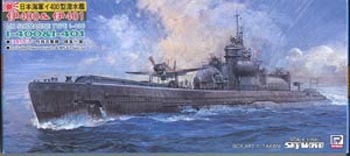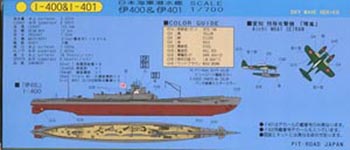IJN 400
Skywave - 1/700
By: Michael
Quan
 The
I-400 class submarine was until recently, all but forgotten among the great
submarines of the world. Not much was widely known about these boats as survivors
were all scrapped shortly after the war. At 393 feet in length and displacing 6,560
tons submerged and 3550 tons on the surface, they were the largest submarines
ever built at the end of World War Two, and even today, remain the largest conventionally
powered submarines ever built! They had a speed of 20 knots surfaced, 7 knots
submerged, and with an operational endurance of four months, they could make
a round trip to any port in the world, including New York, with their as-designed
range of 33,000 nautical miles at 16 knots. Despite the formidable 14 cm, (6"),
deck gun carried and eight bow-mounted, torpedo tubes, the "main battery" for
this class of vessel was their three Aichi M6A1 Seiran aircraft, armed with
either 800 kg. bombs or a 45 cm diameter, (17.71"), aerial torpedo.
The
I-400 class submarine was until recently, all but forgotten among the great
submarines of the world. Not much was widely known about these boats as survivors
were all scrapped shortly after the war. At 393 feet in length and displacing 6,560
tons submerged and 3550 tons on the surface, they were the largest submarines
ever built at the end of World War Two, and even today, remain the largest conventionally
powered submarines ever built! They had a speed of 20 knots surfaced, 7 knots
submerged, and with an operational endurance of four months, they could make
a round trip to any port in the world, including New York, with their as-designed
range of 33,000 nautical miles at 16 knots. Despite the formidable 14 cm, (6"),
deck gun carried and eight bow-mounted, torpedo tubes, the "main battery" for
this class of vessel was their three Aichi M6A1 Seiran aircraft, armed with
either 800 kg. bombs or a 45 cm diameter, (17.71"), aerial torpedo.
Starting in the late 1920's, Japan had been operating aircraft carrying submarines,
and exploited this capability more than any other Navy. Initial development
began in early 1942 for the ambitious strategic plan of attacking the Panama
Canal Locks and rendering them inoperable by the use of attack bombers launched
by submarines. In November 1942, a sub-launched, E14Y1 Glen aircraft equipped
with 2 small bombs, on 2 different missions dropped bombs in wooded areas of
Oregon. Spurred on by the potential of this method of attack, the IJN 5th Replenishment
Program called for the construction of a total of 18 I-400 class vessels, along
with the development, construction and training of the associated specialised
Seiran bomber. Construction on the I-400 began on January 18th 1943 at the Kure
Naval Arsenal at Honshu, with the I-401 and I-402 begun later at the Sasebo
Naval Arsenal at Kyushu. The I-403 was to be built at the Kawasaki Heavy Industry
Co., Ltd. at Kobe, but was never laid down. The last of the I-400 class whose
keel was laid down was the I-404 at Kure Naval Arsenal in February 1944, but
she was sunk while under construction after an air raid. The I-400 and I-401
were launched and sent, (along with the I-13 and I-14), on a mission to launch
an aerial attack against Ulithi - the huge U.S. Navy ship anchorage in the western
Pacific. As events transpired, the Japanese surrender caused this attack to
be aborted at sea.
Along with the efforts of the Smithsonian in restoring the sole surviving example
of the Seiran, the recent kit releases in 48th and 72nd by Tamiya of the Seiran
and Nanzan trainer aircraft have rekindled interest in the "Panama Canal Bombers."
Equally fascinating is the engineering that went into the design of the large,
Sentoku (special submarine), type submarine to transport, service and launch
the Aichi bombers. Although Aoshima already had a 700th kit of the I-400 as
a part of the original Waterline Series, it was very dated, fit poorly, and
accuracy was not far removed from the "toy" category. Skywave has been extremely
prolific in 1999, and their latest release in 700th was eagerly welcomed. Two
complete submarines are included in each box, and in contrast to the old Aoshima
release, the subs can be completed as either a waterline, or as a full-hull
model with display stand.
Consisting of a total of 78 medium gray parts moulded on three sprues, the
surface detailing is very exquisite, capturing the sloping levels of the main
deck as well as the widely spaced deck planks with the various cutouts to accommodate
deck equipment. Drain holes, or "scuttles" if you prefer, in the hull, hangar
door and sail are crisply represented; and the model very favourably matches
available references. Two, four-piece Aichi Seiran aircraft are provided, and
although not mentioned at all in the instructions, a third aircraft on the sprues
represents the Nakajima C6N1 Myrt intended to perform scouting and post-attack
assessment (from Truk)!
 Submarine
construction breakdown follows the original Aoshima kit with the waterline hull
split vertically to which the deck and sail are attached. The submerged
hull is a separate, single add-on should a full-hull model be desired. A unique
kit feature is the separate door to the aircraft hangar tube, which permits
displaying the hangar tube open. Indeed, the Skywave instructions, (in Japanese,
of course), show how to add plastic strip to the "floor" of the hangar area,
as well as how to alter the Seiran to depict the "folded" aeroplane configuration
for storage. Many interesting diorama possibilities come to mind with these
options! If any faults can be found, it is limited to the lack of antennas on
the deck aft of the sail - this being remedied by judicious use of stretched
sprue or brass wire.
Submarine
construction breakdown follows the original Aoshima kit with the waterline hull
split vertically to which the deck and sail are attached. The submerged
hull is a separate, single add-on should a full-hull model be desired. A unique
kit feature is the separate door to the aircraft hangar tube, which permits
displaying the hangar tube open. Indeed, the Skywave instructions, (in Japanese,
of course), show how to add plastic strip to the "floor" of the hangar area,
as well as how to alter the Seiran to depict the "folded" aeroplane configuration
for storage. Many interesting diorama possibilities come to mind with these
options! If any faults can be found, it is limited to the lack of antennas on
the deck aft of the sail - this being remedied by judicious use of stretched
sprue or brass wire.
At around $13 per sub, the Skywave kit represents excellent value in 1999,
especially when compared to the original retail of $2.25 for the Aoshima kit
of the early 70's! All told, Skywave's new I-400 kit is a real winner, and with
some discreet finishing, can lead to a solid contest contender!
References:
- The Maru Special, Japanese Naval Vessels #13 - I-400 and I-13 class submarines,
July 1977. Excellent reference with colour centre section painting, and numerous
black and white photos of the subs after surrendering to the U.S. Navy. Japanese
text.
- Monogram Close-Up #13 - Aichi M6A1 Seiran, 1975. Out of print, but it has
some interesting data and photos of the I-400 subs with details of the hangar
arrangements.
- Those with Internet access should not miss this site: The
Transpacific Voyage of HIJMS I-400 for an excellent story by the U.S.
Skipper who sailed her after the war.
 The
I-400 class submarine was until recently, all but forgotten among the great
submarines of the world. Not much was widely known about these boats as survivors
were all scrapped shortly after the war. At 393 feet in length and displacing 6,560
tons submerged and 3550 tons on the surface, they were the largest submarines
ever built at the end of World War Two, and even today, remain the largest conventionally
powered submarines ever built! They had a speed of 20 knots surfaced, 7 knots
submerged, and with an operational endurance of four months, they could make
a round trip to any port in the world, including New York, with their as-designed
range of 33,000 nautical miles at 16 knots. Despite the formidable 14 cm, (6"),
deck gun carried and eight bow-mounted, torpedo tubes, the "main battery" for
this class of vessel was their three Aichi M6A1 Seiran aircraft, armed with
either 800 kg. bombs or a 45 cm diameter, (17.71"), aerial torpedo.
The
I-400 class submarine was until recently, all but forgotten among the great
submarines of the world. Not much was widely known about these boats as survivors
were all scrapped shortly after the war. At 393 feet in length and displacing 6,560
tons submerged and 3550 tons on the surface, they were the largest submarines
ever built at the end of World War Two, and even today, remain the largest conventionally
powered submarines ever built! They had a speed of 20 knots surfaced, 7 knots
submerged, and with an operational endurance of four months, they could make
a round trip to any port in the world, including New York, with their as-designed
range of 33,000 nautical miles at 16 knots. Despite the formidable 14 cm, (6"),
deck gun carried and eight bow-mounted, torpedo tubes, the "main battery" for
this class of vessel was their three Aichi M6A1 Seiran aircraft, armed with
either 800 kg. bombs or a 45 cm diameter, (17.71"), aerial torpedo.  Submarine
construction breakdown follows the original Aoshima kit with the waterline hull
split vertically to which the deck and sail are attached. The submerged
hull is a separate, single add-on should a full-hull model be desired. A unique
kit feature is the separate door to the aircraft hangar tube, which permits
displaying the hangar tube open. Indeed, the Skywave instructions, (in Japanese,
of course), show how to add plastic strip to the "floor" of the hangar area,
as well as how to alter the Seiran to depict the "folded" aeroplane configuration
for storage. Many interesting diorama possibilities come to mind with these
options! If any faults can be found, it is limited to the lack of antennas on
the deck aft of the sail - this being remedied by judicious use of stretched
sprue or brass wire.
Submarine
construction breakdown follows the original Aoshima kit with the waterline hull
split vertically to which the deck and sail are attached. The submerged
hull is a separate, single add-on should a full-hull model be desired. A unique
kit feature is the separate door to the aircraft hangar tube, which permits
displaying the hangar tube open. Indeed, the Skywave instructions, (in Japanese,
of course), show how to add plastic strip to the "floor" of the hangar area,
as well as how to alter the Seiran to depict the "folded" aeroplane configuration
for storage. Many interesting diorama possibilities come to mind with these
options! If any faults can be found, it is limited to the lack of antennas on
the deck aft of the sail - this being remedied by judicious use of stretched
sprue or brass wire.